by Susan Johnston | Apr 9, 2019 | Uncategorized |
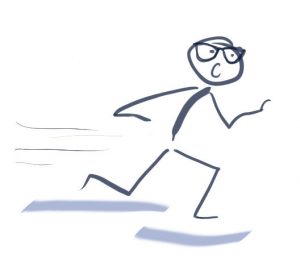 “Half (of the meetings I attend) are completely bizarre and accomplish nothing except bewildering me as to why people don’t run out screaming.” That’s a real quote from a real person about real meetings. Yes, it’s sad. It showed up in an informal survey I did some time ago. Folks told me they spend approximately 40 per cent of their time in meetings, a number consistent with data Perlow, Hadley and Eun found in their 2017 Harvard Business Review Article, “Stop the Meeting Madness.” The authors also found that:
“Half (of the meetings I attend) are completely bizarre and accomplish nothing except bewildering me as to why people don’t run out screaming.” That’s a real quote from a real person about real meetings. Yes, it’s sad. It showed up in an informal survey I did some time ago. Folks told me they spend approximately 40 per cent of their time in meetings, a number consistent with data Perlow, Hadley and Eun found in their 2017 Harvard Business Review Article, “Stop the Meeting Madness.” The authors also found that:
– 71% felt that meetings waste their time
– 65% said meetings keep them from doing their real work
– 66% claim meetings inhibit spending time on deep thinking
Calculate the hard cost of bringing minds together to explore issues, make decisions and plan action. It’s often thousands of salary dollars for a one-hour meeting. (And that doesn’t count travel, doughnuts or the opportunity cost when we delay getting to our other work.)
Then ponder another response, from my survey. “We can’t make decisions or agree on priorities. So, we have the same meeting over and over. Literally, the same meeting.” 
Imagine if every meeting you went to felt like a good investment of your time. It can happen. Good facilitation enables conversations that lead to good decisions. It requires planning – a whole lot more than finding a conference room and sending out a meeting notification.
The first step is identifying the purpose of the meeting, the desired outcome. That leads you to determine who needs to be there – really – and what they need to provide or do. How will you engage people? How will you gather information, analyze it, decide what to do and follow up? All this should be planned before the meeting.
That’s Plan A. You’ll need a Plan B, too, since humans are involved. And you’ll need to be ready to change your plans. Still, to go into meeting a without a plan is almost guaranteed to be a time waster. The more thought and time you invest in planning the meeting, the more relevant and useful the discussion will be – for you and for the participants.
Given that today’s working environment requires collaboration, teamwork and communication, learning to facilitate well may be the most important skill for the 21st century. A facilitator doesn’t do magic. It just looks that way.
+++++++ At It’s Understood Communication, we care about facilitation. Facilitation Skills for the Agile Workplace is a two-day workshop that offers a solid foundation in facilitation, including using visual thinking to build clarity and understanding. Ellen Grove and Sue Johnston are offering it in downtown Toronto, May 6-7, 2019. There are still a few spots left. To learn more and register, visit nobadmeetings.ca At that site, you can also download a PDF copy of our Facilitation Planning Canvas.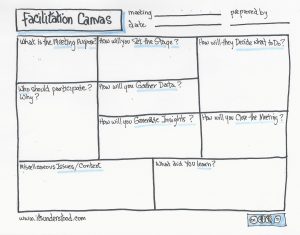
by Susan Johnston | Oct 27, 2017 | Uncategorized |

There’s an old saying, rooted in journalism, that a picture is worth 1,000 words. While we might ask for scientific evidence or challenge the math, most people agree that visuals add enormously to our understanding of things. Humans drew pictures before they developed written language.
 And graphics still convey much important information in our physical world.The visual cortex is the largest system in the human brain – and half the brain is devoted to processing visual information. So it makes sense to supplement our messages with visual information. There are communicators, myself included, who believe we should adapt the Media Richness Theory, which puts face-to-face communication at the top of the scale for conveying information, to add a higher level, face-to-face with a whiteboard.
And graphics still convey much important information in our physical world.The visual cortex is the largest system in the human brain – and half the brain is devoted to processing visual information. So it makes sense to supplement our messages with visual information. There are communicators, myself included, who believe we should adapt the Media Richness Theory, which puts face-to-face communication at the top of the scale for conveying information, to add a higher level, face-to-face with a whiteboard.
All this has led to the evolution and growing popularity of visual facilitation, in which we create images, in real time, to stimulate, focus, enhance and record a discussion. You don’t need to be particularly good at drawing to do this well. The key skill, according to experts, is listening. Sound familiar? That’s the key skill for coaches, facilitators, communicators, product owners, user experience experts and, well, pretty much anyone in a leadership role.
How does visual facilitation help meeting participants?
- Visuals add to their understanding. With more neural tissue devoted to vision than anything else, you stimulate more of
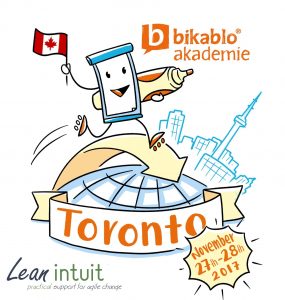 people’s brains with images. They also understand faster. We read images faster than we read text. We “get the picture” with just a glance.
people’s brains with images. They also understand faster. We read images faster than we read text. We “get the picture” with just a glance.
- They’ll remember more of what was discussed. Not only will visual stimulation enhance understanding, it will improve retention and recall. People remember what they see.
- They stay on track. Drawing the discussion encourages focus and prevents people from getting lost in the weeds. If the meeting is about the weeds, that’s a different drawing.
- They may see patterns. As you capture the flow of the discussion, you or the participants may see patterns emerge that might not be noticed with traditional note taking. The picture can depict the flow of ideas, process or products as well as connections between them and their impact on people and things.
- They can see what has been covered in the discussion. Better still, they can clearly see their input has been captured.
- They stay interested longer. Images are just more fun than lists on flip charts. So people will pay attention for longer.
How does visual facilitation help me, as a meeting facilitator?
- You get people’s attention. It’s a big shift from powerpoint, note taking or capturing ideas in an online tool.
- You can capture emotion. Your illustrations can move beyond cold facts and depict the concerns, feelings and reactions of people involved in the discussion.
- You can help people focus on the key elements. What you draw is what they will pay attention to.You don’t have to cover old territory. People can see what has been discussed.
- You can use the finished drawings to share the story with people who were not at the meeting.
You don’t need to be able to draw!
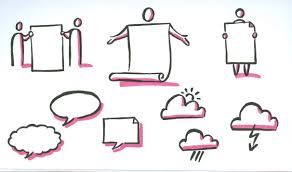
There’s a “visual vocabulary” that anyone can learn. One of this is “bikablo,” a method that emerged in Europe and has caught on worldwide. You master basic techniques for simple illustrations that you can mix. match, adapt and use to tell the story of your meeting. (Leanintuit is bringing bikablo training to Canada – November 27-28. See below for registration details!)
Other ideas to explore:

- Teach your team members to express themselves visually. It encourages collaboration when you all draw together. It’s also a way to engage quiet people and those whose first language is not the team’s working language.
- Attract people to your booth at conferences or trade shows. It will immediately make you stand out from the crowd because something is happening live and in person.
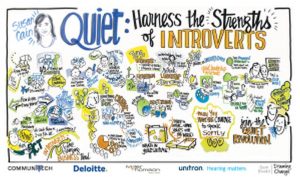
- Capture the proceedings from conference sessions. That way people can see what happened in the concurrent sessions they missed. Or they can gather at the recording of the keynote talk and discuss particular elements. (This graphic, by Sam Bradd, depicts a keynote session I attended at a Communitech conference. A great reminder of Susan Cain’s excellent talk.)
- Create your own illustrations for your presentation slides. This can save you hours of searching through stock image sites. When you create it yourself, you get exactly what you want.
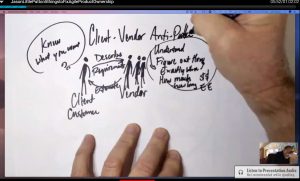
- Draw your presentation. Jeff Patton (see image) and Dave Gray, leaders the agile and user experience communities, respectively, use overhead projectors and sketch out their presentations while they talk. Super engaging!
Training in Toronto – November 27-28
 If you can get to Toronto for a couple of days at the end of November, you have a unique opportunity to learn visual facilitation from the best. We’ve invited Andrea Rawanschad, of the bikablo academie , in Cologne, Germany, to return to Canada and run a second two-day workshop. The first Canadian session, earlier this fall, sold out quickly and was a hit with participants. For those who couldn’t attend the first session – or didn’t know about it – we’ll be gathering in downtown Toronto on November 27 and 28. With a maximum of 12 people in the class, there are just a few spots left, so don’t delay. To learn more and register for this unique experience, follow this link.
If you can get to Toronto for a couple of days at the end of November, you have a unique opportunity to learn visual facilitation from the best. We’ve invited Andrea Rawanschad, of the bikablo academie , in Cologne, Germany, to return to Canada and run a second two-day workshop. The first Canadian session, earlier this fall, sold out quickly and was a hit with participants. For those who couldn’t attend the first session – or didn’t know about it – we’ll be gathering in downtown Toronto on November 27 and 28. With a maximum of 12 people in the class, there are just a few spots left, so don’t delay. To learn more and register for this unique experience, follow this link.
If you have questions – contact me.

by Susan Johnston | Jun 9, 2015 | Uncategorized |
 Yesterday, at Agile Coach Camp Canada, I had the privilege of leading a group conversation about taking care of yourself as a coach.
Yesterday, at Agile Coach Camp Canada, I had the privilege of leading a group conversation about taking care of yourself as a coach.
The Big Idea is like the instruction flight attendants give us, “If you are travelling with a child or someone who requires assistance, secure your mask first, and then assist the other person.” As coaches – or as anyone – we don’t have much to give others if we don’t take care of ourselves.
The coaches who gathered for the session agreed that people attracted to the work of helping others often put our own needs behind those of our teams and our organizations. That habit can result in fatigue, stress, and burnout. It impacts relationships both at work and at home.
Here’s the list we built in the conversation:
What can we do to take care of ourselves?
Notice when you’re feeling depleted.
Show yourself some compassion.
Give yourself some space.
– Close the door
– Go for a walk – preferably outside, in a pleasant place
– Physical activity – “I bike to work.”
– Announce it, in a light way. “I let the team know I may be a bit of a Grumpus today.”
Do something you enjoy and are good at
– “I do some real, individual coaching. That lets me see I’m making a difference. It’s almost like a gift to myself.”
Use your network
– “I call another coach and I know I’m not in this alone.”
– “I get coached myself. It’s time I have to focus on me.”
Make your work and success visible
– Personal kanban
– Read your fan mail
– List your successes
– Find a win, however small
Spend some time in reflection
– Journalling
– Mindfulness practice
Let people know what’s fun for you
Manage expectations
– yours and others
– “Accept that our work is messy and it’s a journey.”
Say “no” to more work
– “If you can’t say “No” then your “Yes” can turn into a “Maybe” ”
– “I’d rather disappoint you now, with a “No,” than disappoint you later by being unreliable.”
Gratitude
– Think of things you’re grateful for
– Practise thanking – and accepting thanks
– Appreciate it when others thank you – and show it
– Savour the kudos
Know your purpose and only do what’s aligned with that
Spend some time just doing nothing
– “The brain needs to rest just like any muscle.”
Hugs
– More hugs
One in our group, Gitte Klitgaard, was on her way to a tech conference in New York where her talk was “Stress and Depression – The Taboo and What We Can Do About It.” A link to an earlier version of that talk is at vimeo.com/106927863
Our conversation reminded us that we need to recognize we’re human and show ourselves the empathy and compassion we show our teams and coaching clients.
Note: If you are an agile coach and have never been to an Agile Coach Camp, plan on attending one when you can. They are impossible to describe and they are amazing. There’s one, this weekend, in Calgary, Alberta and one coming up in Washington, DC, August 1st.
by Susan Johnston | Mar 20, 2015 | Uncategorized |
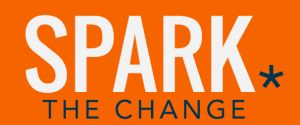
With just over a month to go till the Spark The Change conference, I’ve been thinking a lot about change in the workplace.
As an organizational communicator – and even as a coach – my work has always been about change. “Everything is the same as it was yesterday,” is not a message I’ve ever sent, or even heard. While “no change” may be a true reflection of the situation, it’s not something we shout about. Even when we wish things would just stop changing for a second, while we catch our breath, we know it’s not realistic. When markets, environments, regulations, politics, consumer preferences, off-shoring, competitors, technology and a zillion other factors demand that we adjust and respond, not changing is not surviving.
But how do you do it?
We know what doesn’t work.
Scare tactics
When I first worked in change management, in the late 1980s, my organization hired high-priced consultants to tell us what to do. The prevailing idea was, “Scare people into changing.”
I recall the mantra, “Change or Be Changed.” I’m sure I wrote it into several executive speeches and articles for assorted publications. The idea was that, if we don’t voluntarily change the way we do things, something will come along and force us to do it. Might as well do it now than go kicking and screaming. Or maybe we could do it next week. What’s wrong with a good kick and scream?
We told stories about the “burning platform,” in which a worker caught on a blazing North Sea oil rig chose probable death over certain death, jumped off the drilling platform into the icy sea and was rescued. Only a blaze would have caused that behaviour change. This story was designed to get us to develop a sense of urgency around the need to change. But when employees look around and see that you have lots of customers, you’re raking in profits, nothing seems to be changing except the rhetoric and your CEO is taking a million dollar bonus, things don’t look particularly urgent.
One consultant trotted out my old friend Kurt Lewin, from Psychology 315 and his metaphor of ice. If you want the ice to change from a cube to a pyramid, you have to unfreeze and refreeze it in the new shape. (Could we use the burning platform to melt it?) We’d have to give up cherished beliefs about our selves and our organization and challenge the status quo. Not easy for executives and managers who were very well treated by the status quo. While we were sloshing around in that liquified state, waiting to refreeze into the new status quo, things would be chaotic, disordered and generally awful. No wonder people resist change.
Yes, we would meet resistance. Yet we knew (as the Borg kept telling us on Star Trek) “Resistance is futile.” The favoured model of resistance was the (Elizabeth) Kubler-Ross Grief Cycle, in which someone needs to pass through Denial, Anger, Depression and Bargaining to get to Acceptance. Why grief? Well the old ways were dead. We needed to mourn and move on. I remember thinking that, even though I understood the “why” for change and was 100 per cent behind the notion that we had to do it, I was, nevertheless, resisting. I wanted proof we would actually do it and that it would work. More than that, I wanted someone else to go first. I don’t think I got past Bargaining. And if I, the Change Girl, wouldn’t go, who else would?
Communication was acknowledged to be a key success factor or I wouldn’t have been involved. The why of the change wasn’t hard to describe. But what and how were a mystery. I’d prepare messages that reflected what employees wanted to hear, which was, “This is going to be hard but here’s how we’ll support you.” Then I’d prepare messages that reflected what executives wanted to say, which was mostly, “Bla bla bla.”
Appreciative Approach
What I wish we’d known about in those old days of “change management” was how to take an appreciative approach. Instead of scaring people into different behaviours, why not unleash them to find their own way? While we were freezing and burning and and resisting things, a grad student named David Cooperrider was “unfreezing” our notions of change. His process, Appreciative Inquiry, shifts organizational change from a problem to be solved to a creative endeavour. We ask questions about what’s working and have conversations about how we got that and how to get more. It sees the organization as organic, alive and able to change because it has done so in the past. By examining what is right and good, people are reminded of their abilities and resilience. They have more confidence and comfort to journey into the unknown future when they bring forward known parts of their past.
New ideas and tools
Appreciative Inquiry is just one of many tools we have today that we didn’t know about in the ’80s. We also have the benefit of knowing, thanks to advances in neuroscience, how human brains work. And we can talk about how we feel about change, thanks to the widespread acceptance of emotional intelligence as a factor in success.
I’m looking forward to Spark The Change, April 23, in Toronto where I expect to collide with people from diverse disciplines and types of organizations who want to create better workplaces. I’m anxious to hear new ideas from speakers who aren’t just talking about change, they’re doing it. I know we can create organizations that not only operate more successfully as enterprises but are also saner places to work.
by Susan Johnston | Dec 19, 2014 | Uncategorized |
 When I first studied accounting I was astonished that “goodwill” is something you can quantify and express with a financial value. I’d always thought of it as kind thoughts towards my fellow humans. Those are valuable, for sure, but not exactly something you can put a dollar sign on.
When I first studied accounting I was astonished that “goodwill” is something you can quantify and express with a financial value. I’d always thought of it as kind thoughts towards my fellow humans. Those are valuable, for sure, but not exactly something you can put a dollar sign on.
Along come generally accepted accounting principles (GAAP) to tell us that goodwill isn’t just about benevolent feelings towards others. It’s also the amount one company pays to buy another that’s over and above the tangible value of the assets being acquired. How could a company be worth more than its tangible assets? A strong brand, customer relationships, intellectual property and existing contracts might qualify as goodwill. It sits on the balance sheet as an intangible asset.
It’s interesting to ponder the value of goodwill during this season of “Gloria. Peace on Earth to men of goodwill.”
Goodwill, the kind thoughts variety, makes us worth much more than our tangible assets. It connects us to others, something we need to keep us human. There’s ample evidence of a link between the mind and the body that suggests positive thoughts and acts of generosity lead to more than just good feelings – they promote physical health. The explanation is that reciprocal benevolence kept our ancestors alive back in the days of “kill or be killed.” So we’re wired to be kind to each other.
You might argue that we don’t have to look far to find people whose learning or circumstances and choices override that basic human inclination towards goodwill. We see the impact of extremism and zealotry on the nightly news.
As I write that, I’m reminded of a quote from Anne Frank, who wrote, as she was hiding from the Nazis, “Despite everything, I believe that people are really good at heart.”
We can choose goodwill. Each of us can do our own bit to look for the best in others. As coaches, it’s our job to not only see their best but also to help them see it – and do something with it. Anne Frank said it best, “Everyone has inside of him a piece of good news. The good news is that you don’t know how great you can be! How much you can love! What you can accomplish! And what your potential is!”
This is a series inspired by House of Friendship Kitchener’s 12 Days for Good project. There’s a theme for each of the 12 days – no pipers piping required. Learn more at http://12daysforgood.com
by Susan Johnston | Dec 13, 2014 | Uncategorized |
 “Safe travels!” We hear that a lot, this time of year, when folks head off for the holidays. What does it mean to be safe?
“Safe travels!” We hear that a lot, this time of year, when folks head off for the holidays. What does it mean to be safe?
My first official memory of safety involves Elmer the Safety Elephant. We met him in kindergarten and he was a fixture in our primary and elementary school lives. Since “an elephant never forgets,” Elmer’s job was to remind us to be careful. He had his own flag and it was a big deal to help put up the Elmer flag every day, signalling that the school had been accident free. He had five safety rules:
- Look both ways before crossing the street.
- Don’t go between parked cars.
- Ride your bicycle safely and obey signs and signals.
- Play games in safe places, away from traffic.
- Walk, don’t run, when you leave the curb.
Elmer was born in Toronto in 1947, through a collaboration of the mayor, the police department and one of the daily newspapers. This vintage CBC video tells the story. (It’s worth a peek just to see the cars.) Child accidents declined and word spread across the nation. A national program followed and children in the hinterland, like me, got to meet him and learn and practise his five rules.
“Whatever happened to Elmer?” I wondered, this morning. Well, boys and girls, he’s still around. Like so many other celebrities, he’s had a facelift to counteract the effects of aging. And today, in addition to traffic safety, he now dispenses wisdom about fire safety, railway safety and Internet safety.
As adults, how do we channel our “inner Elmer?” Safe driving, snow tires, shovelled sidewaks, fresh batteries in the smoke detectors, holding the handrail and, yes, looking both ways – all these promote physical safety for ourselves and others.
I also think about another sort of safety.
- How do we make it safe for people to express themselves?
- How do we encourage people to listen to ideas with open minds?
- How do we encourage people to speak up about things that matter and ask questions about things that puzzle us without fear of being judged, labelled and dismissed?
One way to do that is to be conscious about our communication. We can assess the impact of our words before we speak them. We can share the intention that lies behind them. We can listen to understand, rather than simply to respond.
We create a climate of safety. Just like Elmer.
This is a series inspired by House of Friendship Kitchener’s 12 Days for Good project. There’s a theme for each of the 12 days – no geese-a-laying required. Learn more at http://12daysforgood.com
 “Half (of the meetings I attend) are completely bizarre and accomplish nothing except bewildering me as to why people don’t run out screaming.” That’s a real quote from a real person about real meetings. Yes, it’s sad. It showed up in an informal survey I did some time ago. Folks told me they spend approximately 40 per cent of their time in meetings, a number consistent with data Perlow, Hadley and Eun found in their 2017 Harvard Business Review Article, “Stop the Meeting Madness.” The authors also found that:
“Half (of the meetings I attend) are completely bizarre and accomplish nothing except bewildering me as to why people don’t run out screaming.” That’s a real quote from a real person about real meetings. Yes, it’s sad. It showed up in an informal survey I did some time ago. Folks told me they spend approximately 40 per cent of their time in meetings, a number consistent with data Perlow, Hadley and Eun found in their 2017 Harvard Business Review Article, “Stop the Meeting Madness.” The authors also found that:












